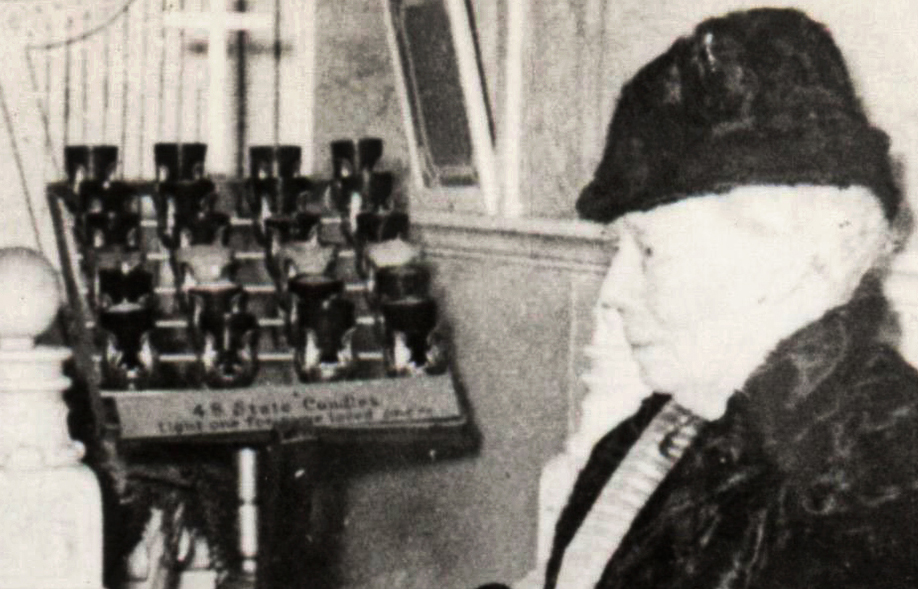|
|


Click image to enlarge
| Download archival scan
Owner Robert E. Callahan is joined by American composer Carrie Jacobs Bond (1862-1946) inside the tiny Ramona Chapel at Callahan's Mission Village in Culver City in 1927. Mission Village was an "Indian"-themed auto park that centered around author Helen Hunt Jackson's character, "Ramona" (1884). Callahan (1892-1981) was a collector of Western Americana and cobbeled together the chapel in 1926 from parts he gathered. In 1963 he moved his collection to 13660 Sierra Highway in Saugus (as it was then known). In 1987 his widow, Marion Callahan, donated the chapel and other belongings to the Santa Clarita Valley Historical Society. The chapel now sits in Heritage Juction Historic Park inside William S. Hart Park in Newhall.
Two essentially identical copy prints — in this case, photographs of a photograph — reside in the Historical Society collection, one of which appears above. The copy prints were made in 1963 when Callahan opened his Old West Trading Post on Sierra Highway. The underlying print hung on a wall there with a caption/description written by Callahan. A typewritten inscription on the back of one of the two copy prints gives the date, 1927. Callahan's original caption is only partially visible in the copy prints (download it here). The visible portion states that Bond designed the chapel. It also states that Bond was the "most famous woman composer in America," which she probably was. The first woman to sell 1 million copies of a song, she wrote approximately 175 of them including "I Love You Truly" (1901) and "The End of a Perfect Day" (1910). Bond also donated the 48-cup brass candelabra seen in the photo — one for each of the 48 states, according to its signage. Bond appears to be wearing the same outfit in one quick scene in the 1933 documentary feature below. Further reading: Ramona Chapel Gets a Facelift, 2001.
About Callahan's Old West. Robert E. Callahan's Old West Trading Post, aka Indian Village, at 13660 Sierra Highway in "Outlaw Canyon" was the equivalent of an amusement park of its day. Callahan (b. Oct. 27, 1892; d. Jan. 10, 1981), an entertainer and novelist, exploited America's fascination with all things Western — especially the romanticized notions of Old California as presented by Helen Hunt Jackson in her seminal 1884 novel, "Ramona" — by collecting objects with a connection, real or imagined, to the novelist and her work, and enticing the public to experience them. Callahan's initial visions of creating an amusement park to be called Ramona Village morphed into the Mission Village Auto Court, which he opened in 1926 at 5675 W. Washington Blvd. in Culver City. Along with a themed hotel, he erected teepees for travelers and put his collections on display, including a chapel, little red schoolhouse and kiva (a small sweat lodge). Auto parks were big business as the automobile came into age in the 1920s. There were a few auto parks in the Santa Clarita Valley, most notably McIntyre's camp at Castaic Junction, which was wiped out in the 1928 St. Francis Dam disaster. In time, L.A. city builders had a different vision for Callahan's Culver City property. By the early 1960s, Mission Village stood in the way of the coming I-10 Santa Monica Freeway. So in 1962 Callahan closed Mission Village and moved it to 13660 Sierra Highway. (The freeway was completed in 1965). Note: In Callahan's day, that part of Sierra Highway was known as Saugus. The county of Los Angeles later included it within the Acton-Agua Dulce Town Council's sphere of influence. It is commonly considered part of Agua Dulce today. In 1987, Callahan's widow, Marion, donated several artifacts from the former Indian Village — including the Ramona Chapel and little red schoolhouse — to the Santa Clarita Valley Historical Society. The main building remained on the property, and from From 1986-2000, Marion Callahan leased it to the Canyon Theatre Guild. In 2000 the CTG moved back to downtown Newhall where the community theatre had started.
HS3674: 9600 dpi jpeg from copy print, SCV Historical Society collection. Essentially the same as HS3673.
|
Pollack Story
Callahan & Carrie Jacobs Bond in Ramona Chapel 1927
Ramona Cottage ~1930s
~1940s
Callahan with Hopi Indians Employees
Good Luck Charm
'Hopi Snake Dance' Booklet
Description 1965
1967 Visit x3
Tom Shubert Story
Ray Saniger Performs 1967/70 (Mult.)
Summer of 1967
1972 Horror Film
Outlaw Saloon
Hopi Shrine
Red Schoolhouse
Ramona Chapel
Main Building
Good Luck Charm
Wrong Address
Good Luck Charm
Correct Address
$1,000 Las Vegas Loot
Schoolhouse Origin
The Callahan Collection: Donation Records
Schoolhouse Arrives 1987
Ramona Cradle x2
|
The site owner makes no assertions as to ownership of any original copyrights to digitized images. However, these images are intended for Personal or Research use only. Any other kind of use, including but not limited to commercial or scholarly publication in any medium or format, public exhibition, or use online or in a web site, may be subject to additional restrictions including but not limited to the copyrights held by parties other than the site owner. USERS ARE SOLELY RESPONSIBLE for determining the existence of such rights and for obtaining any permissions and/or paying associated fees necessary for the proposed use.
























